|
Signal Model Based Synthesis of the Sound of Organ Pipes
Introduction
It is well known for musicians and also sound engineers that
today's exclusively used sound synthesis method in synthesizers and digital
instruments is the so-called PCM method to reproduce/recreate the sound of
acoustical instruments. The basis of this method is that the sound of the
instrument is recorded, the record is compressed ("looped", taking into
consideration the periodicity of the signal's stationary part) and stored. The
method is even more efficient if it also takes into account that the neighboring
pitches of the instrument are nearly the same, so using resampling techniques,
even more memory space could be saved. The greatest disadvantage of this method
is, however, that it cannot reproduce the stochastical behaviour of the
instrument (i.e., noise, modulations, other random events).
To eliminate the problems of the sampling synthesis, a new
synthesis method has been introduced in the 80's. The Physical Modeling (PM)
tries to model not the sound, but the instrument itself. Using the instrument's
parameters and its mathematical-physical relationships (based on the
differential equations of the musical instrument), the sound of the instrument
can be calculated. The problem of this approach is that large computational
power is needed for high-quality modeling.
The signal model
Signal model based synthesis could be a well-balanced
compromise between the computation efficiency and the sound quality. In this
case first the deterministic and stochastic properties of the sound of an
instrument are analyzed. Later, using the parameters come from the analysis, the
reproduced sound become high-fidelity if the model is accurate enough.
As many of the musical instruments generate nearly periodic
sound, the signal model is based on the discrete-time model of the periodic
signals. From another point of view we have searched the answer to the following
question: Is it possible to generate good-quality model using the classical,
Fourier-expansion based (so-called additive) synthesis method,
completed with some auxiliary signal processing (such as modulators,
noise-generators, filters)?
The final organ-model has been set during the experiments (see
also the next section). The model has three parts with three different functions
(see Figure 1):

Figure 1. The signal model used for modeling
pipe-organs
Analysis
The parameters of the organpipe-models were derived off-line
from original pipe-records. We have measured many pipes from three different
organs in order to get the quantitative characteristics of each stops, and to
set the significance of each parameter (e.g., the precision of modeling the
transients).
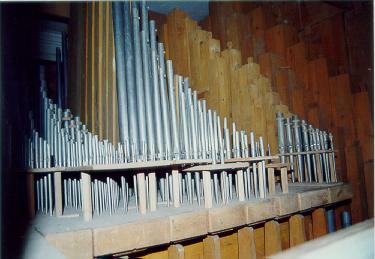 |
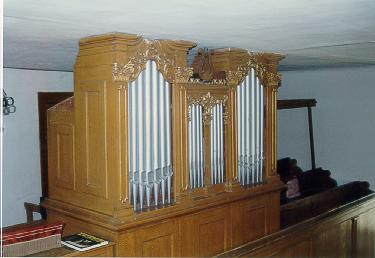 |
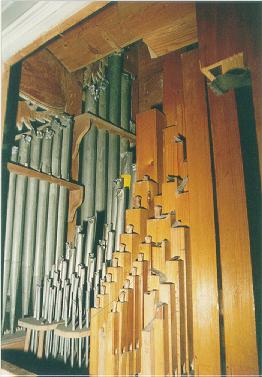
|
|
Church of Császár |
Church of Naszály |
Church of
Tata |
Figure 2. The measured organs
Using a fully automatic analysis process, we could find both
the determinisctic and stochastic numerical parameters. The whole process can be
seen in Figure 3.
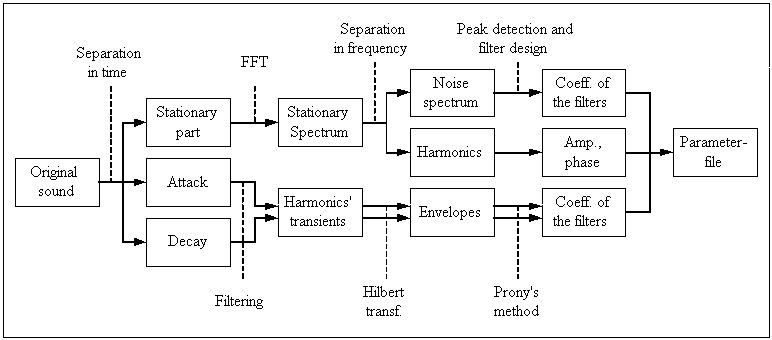
Figure 3. The whole analysis process
Synthesis
The synthesis - based on the measured parameters - has been
implemented real-time and also off-line. First we have used a Motorola 56001
Digital Signal Processor (DSP), later - to implement more feature - we have
changed to an Analog Devices DSP. To make more polyphonic models, an off-line
synthesis program under MATLAB has also been developed. The block-diagram of the
synthesis can be seen in Figure 4.
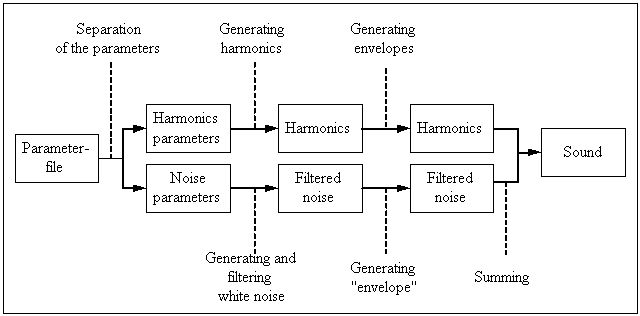
Figure 4. Synthesis of organ sound
Results
The efficiency of the proposed model can be verified by
listening to the sound examples (next section), and also by some quantitative
measures. The following two pictures have been made using MATLAB. Figure 5
shows an original and model spectrum, while in Fig. 6 the attack transients of
an original and model pipe can be seen.

Figure 5. Spectrum of original and model Bourdon
pipe

Figure 6. Attack transients of the first 8 harmonics of an
original and modeled Diapason pipe
Sound examples
The following links contain some demonstration records. One can
compare original organ sound with its model, off-line simulation results of a
larger organ and real-time implementation of one Bourdon register. The files
are in mp3 format.
- J. S. Bach: Ich
ruf zu Dir choral (fragment)
Matlab simulation, Stops: Diapason 8',
Diapason 4', Bourdon 8', Octavbass 8', Subbass 16'. (Size: 495 kb, length: 30
sec)
- J. S. Bach: Ach,
was soll ich, Sünder, machen choral(fragment)
Original recordings
in the Reformed church of Naszály, 1 Bourdon 8' stop. (Size: 513 kb, length:
32 sec)
- J. S. Bach: Ach,
was soll ich, Sünder, machen choral (fragment)
Matlab
simulation, 1 Bourdon 8' stop. (Size: 512 kb, length: 32 sec)
- J. S. Bach: Two
part invention in F major (fragment)
ADSP2181 DSP, real-time, 1
Bourdon 8' stop, 3 part poliphony, 8 harmonics/pipe. (Size: 676 kb, length: 42
sec)
- J. S. Bach: Ich
ruf zu Dir choral (complete)
Matlab simulation, Stops:
Diapason 8', Diapason 4', Bourdon 8', Octavbass 8', Subbass 16'. (Size: 2.7
Mb, length: 2 min 50 sec)
Related Publication:
Useful Links:
Manufacturers of digital organs
Further information: János Márkus
|